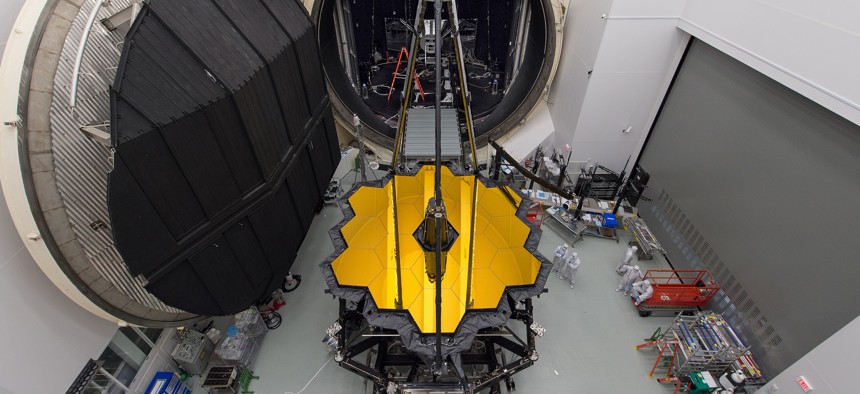
Desiree Stover/NASA
NASA's New Space Telescope Is in Harvey's Path
Here’s how they’re protecting the $8.6 billion project.
As tropical storm Harvey continues to drench Houston, turning streets into muddy rivers, NASA workers are keeping watch over a giant $8.6 billion space telescope at the edge of the city.
The James Webb Space Telescope is currently sitting inside a massive, sealed cryogenic chamber at the Johnson Space Center, a sprawling NASA facility in southeast Houston. In July, Webb began a 100-day stint in the vault-like chamber, which simulates the extreme conditions in space. Vacuum pumps remove the air inside the chamber, and liquid nitrogen and helium get pumped in to produce temperatures found in deep space.
As Harvey moved inland, an emergency-operations Twitter account for Johnson reported flooding in the area, tweeting early Sunday morning: “Getting multiple reports of flooding homes all around our area. Water on site is over the sidewalks approaching steps. Knee deep in streets.” A Sunday morning tweet said the complex had received 22 inches of rain, and an afternoon tweet reported “heavy rain hammering us again. (More than 31 inches of rain have fallen, according to the latest statement from Johnson Monday afternoon.)
The reports must have worried some Webb fans, leading NASA to publicly reassure people on Monday:
We appreciate the concern for @NASAWebb. Our personnel and hardware are safe and everyone is taking appropriate precautions. #JWST #Harvey
— NASA Webb Telescope (@NASAWebb) August 28, 2017
William Jeffs, a spokesperson for Johnson Space Center, said in an email Monday there have been “no issues with operations.” “All backup facility systems required to maintain the telescope have been checked and readied for use if necessary,” Jeffs said.
The concern is understandable. The Webb telescope, with its 21-foot-tall gold-coated mirrors, has been in the works for more than two decades. The telescope will be 100 times more powerful than its scientific predecessor, the Hubble Space Telescope. Scientists are relying on Webb to peer into the universe farther than ever before, showing humanity the earliest stars and galaxies. It’s scheduled to launch next year. The thought of flooding described as “catastrophic” getting anywhere near Webb rattles the nerves.
Sarah Kendrew, an astronomer and instrument scientist at the European Space Agency, traveled from Baltimore to Houston Tuesday to support Webb’s testing operations. “I thought I knew about rain (I lived in Britain for a long time!), but nothing could have prepared me for what we are seeing here at the moment,” Kendrew wrote in an email. “Every time I think we’re through the worst of the storm and it can’t possibly rain any more, another wave hits us with relentless rain, and often violent thunder and lightning.”
Kendrew said staffers were feeling anxious, and many slept in offices or conference rooms at Johnson when they couldn’t get home or to hotel rooms. “It’s been challenging at times to concentrate on work whilst our phones are sounding emergency flood and tornado alerts several times an hour, and knowing that people just miles from our desks, maybe even family or friends, are in danger and possibly losing their homes,” she said. But “we’ve actually been able to continue amazingly well with the testing,” she said.
NASA has shut down Johnson Space Center for all employees except essential personnel, like members of the center’s flight-control room, which communicates with the International Space Station. Royce Renfrew, an ISS flight director at Johnson, drove into Johnson Sunday night, slept in the office, and began his work supporting the space station Monday morning. Renfrew said in an email that others who live nearby took advantage of breaks in rainfall to commute.
“This event will become yet another item of lore in the long history of flight operations for young flight controllers to learn from,” Renfrew said.







